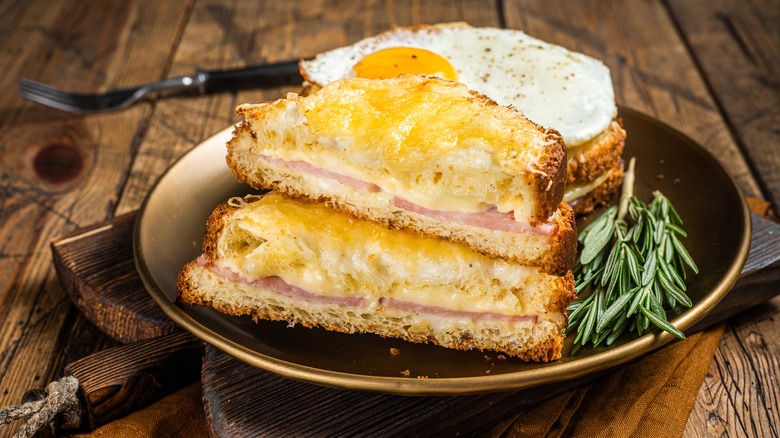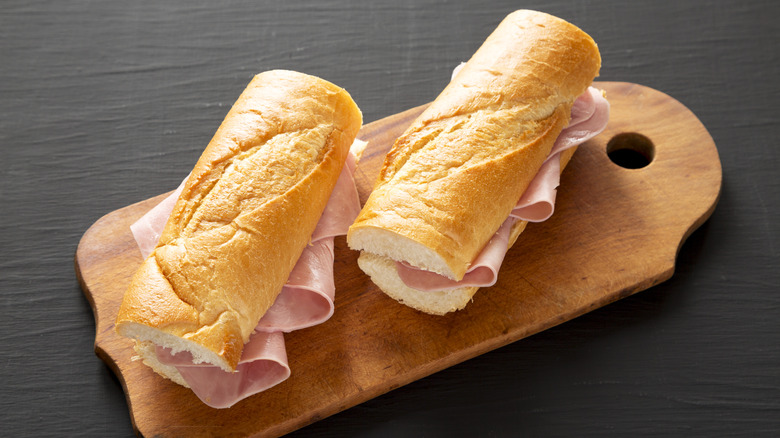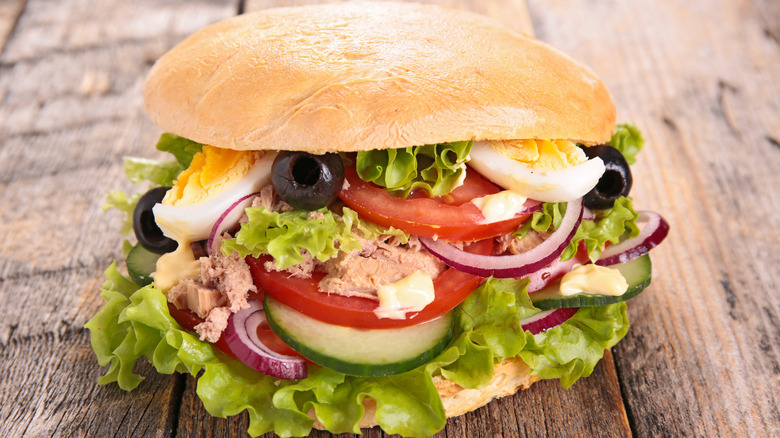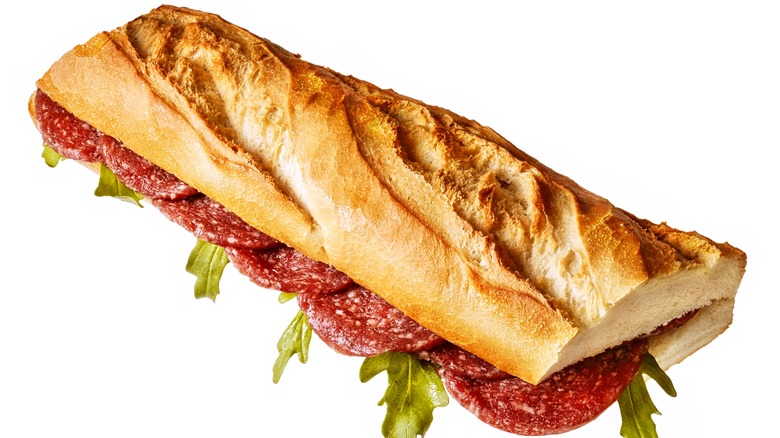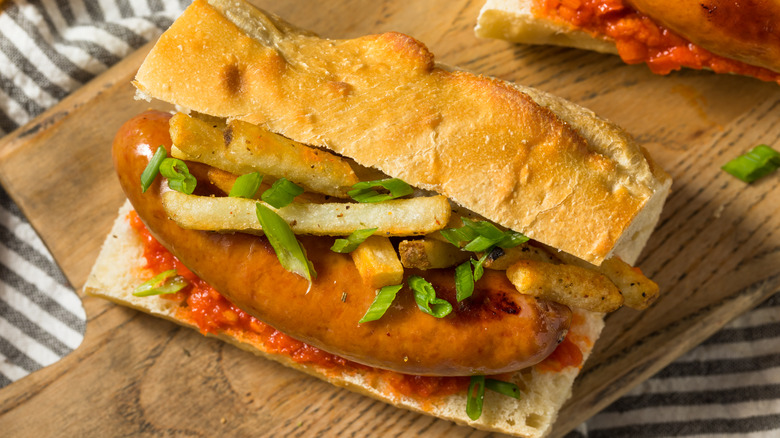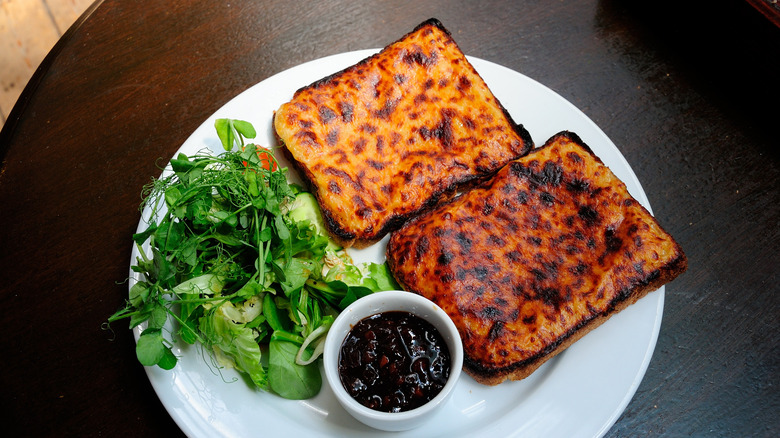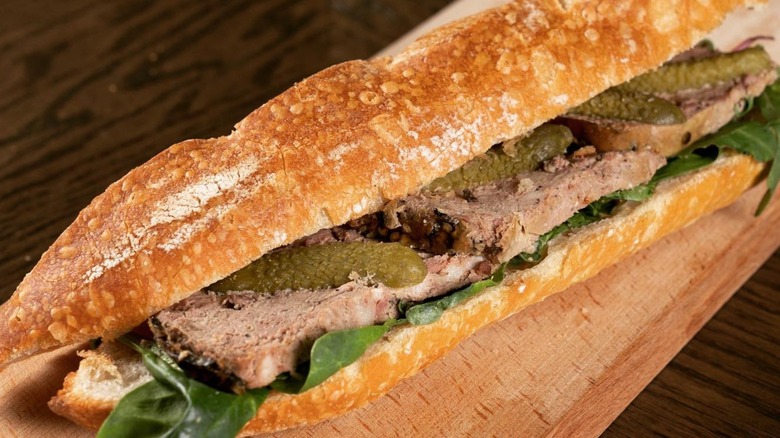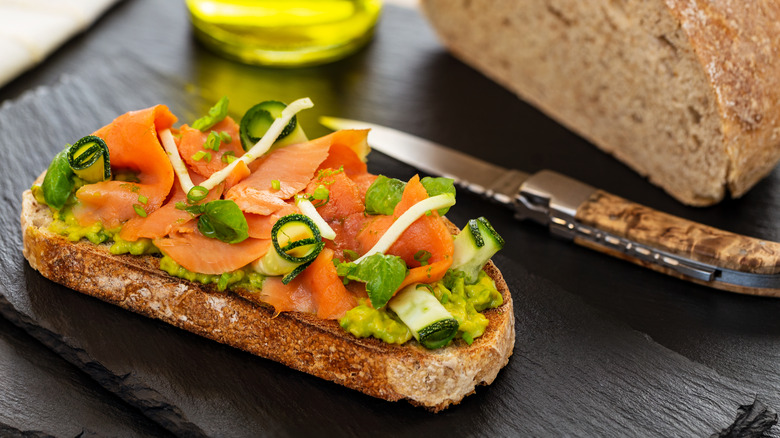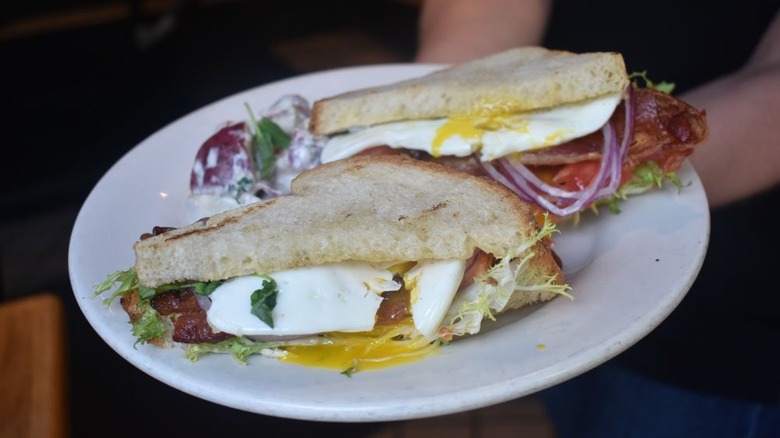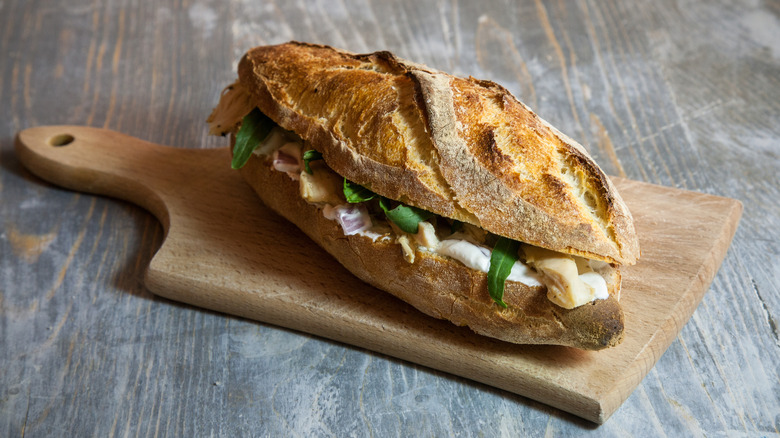11 French Sandwiches You Need To Try At Least Once
France has a rich and storied culinary culture that spans from late-night street vendors and markets to some of the finest dining experiences on the planet. Bistros, bakeries, and sidewalk cafes serve well-known salads and sandwiches, while classic dishes change and new ones emerge in French brasseries. In France, like America, sandwiches can be a quick snack that's grabbed alongside your morning coffee or a full-fledged meal at a sit-down restaurant; it all depends on the context. The sandwiches on this list are found in all sorts of places and situations. Most are not only made in a French style but require French ingredients as well. It's a mix of these aspects that truly gives a dish its national identity.
A lot of travel guides will tell you that there's French food that tourists eat, and then there's authentic French food — but that doesn't matter as much in the case of sandwiches. Whether you're visiting France, eating at a local French-inspired restaurant, or making these at home, you won't want to miss any of these unique combinations.
Croque monsieur and madame
The croque monsieur is one of the most well-known French sandwiches there is. It's a classic dish that has found its way onto many menus not only in France but across the world. The word croquer is French for "bite", and the monsieur part of the name is shrouded in a little uncertainty, but it means gentleman or sir.
Croque monsieur is made with boiled ham and Gruyère cheese on the inside of the sandwich that is beaten with egg and/or sprinkles of shredded cheese that melts into a crust around the sandwich. Depending on the recipe, it can be cooked in an oven or a frying pan, and more often than not, requires a little bit of both to get the right texture and consistency. The croque monsieur is made with a French version of white bread called pain de mie, something that sets it apart from most French sandwiches that are made with crispy baguette bread. Some French restaurants will serve the croque monsieur with a béchamel sauce, which has become a defining ingredient for the sandwich in the past few decades.
The croque monsieur has also inspired the creation of a few other popular sandwiches. The most popular variation is the croque madame, which adds a fried egg to the top of the sandwich. The monsieur is usually served as a lunchtime meal, while the madame is often eaten as a breakfast dish.
Jambon-beurre
Jambon-buerre is a sandwich that you'll find a version of in almost every French bistro, made with simple French ingredients and classic baguette bread. The history of the jambon-beurre reaches back to the 1800s, when it began as a simple and healthy snack for working- and middle-class French people. It started out as ham or a piece of fried lard on a half-baguette, but over time it evolved to include hand-churned butter and jams. Jambon-beurre literally means "ham-butter," but that doesn't mean you can't add other things to it. Of course, to really get the French experience, you'll want to try it in its classic form — but it is a highly customizable sandwich.
The sandwich is usually very affordable and quick to make, which has cemented it as a centerpiece of French cuisine and daily life in France. For a true jambon-beurre, make sure to avoid smoked or honeyed hams and instead aim for jambon de Paris, which is wet-cured and cooked in a mold. It has less salt than your average lunch meat. As for butter, unsalted is common.
Over time, the jambon-beurre has seen rises and falls in its popularity in France. Changes in industrialization, food processing, and bread making have seen this classic meal fight for attention against the advent of cheeseburgers and other fast foods. In the end, the sandwiches' true French identity won the day and is now a cornerstone of French dining.
Pan bagnat
The pan bagnat originated in southeastern France, where fishermen used local ingredients to make sustaining sandwiches to get them through their work. No wonder pan bagnat means "wet bread!"
The ingredients of the pan bagnat: Served in a round piece of French sourdough that is made especially for pan bagnats, the sandwich is filled with onions, tomatoes, olives, beans, and other raw vegetables. Add to that a hard-boiled egg and plenty of olive oil, salt, pepper, and the most important ingredient: fish.
A classic pan bagnat is made with tuna, but versions of the sandwiches found in the French Riviera sometimes use anchovies instead. If these ingredients sound familiar, it's because this sandwich is essentially the salade Niçoise in sandwich form. The pan bagnat is very popular in Nice, but versions of this sandwich can be found across the whole country. Due to its relative complexity compared to some of the other sandwiches on this list, it is more often found in sit-down restaurants than on the go.
Saucisson sec
The saucisson sec sandwichis at its core identical to the jambon-beurre but with a dry French salami (known as saucisson sec) paired with butter on baguette bread. While this may sound too similar, the French sandwiches are actually quite different. The flavor of ham and butter tastes relatively similar across the country, while the saucisson used for your sandwich could have completely different flavors depending on the region. You may get a spicy cured sausage or one made from duck, for example.
The rich depth of saucisson also changes what the French pair with their sandwiches. For example, while the jambon-beurre might taste great with a sweet jam, the saucisson sec is often served with savory cornichons. This isn't your everyday salami and pickle sandwich; Saucisson sec is a great example of a dish that just isn't the same without its essential French ingredients. It will be best at a cafe, bistro, or anywhere you see locals ordering it.
Sandwich de merguez
French dining is not confined to just fancy restaurants or picnics in the park — it is also the street vendors and the nightlife, the food that represents not what France was but what it is and will be. This is evident in many aspects of French cuisine, but it is especially in focus with something like the sandwich de merguez. The sandwich has influence from roots in North Africa, where the spicy lamb sausage merguez comes from. The sausage is heavily spiced with a mix of ingredients, from harissa to sumac, fennel, garlic, and chili pepper.
The sandwich de merguez can be made with any number of different condiments (yes, condiments, since this sandwich is known as a French street food version of hot dogs). One of the most popular additions is frites, which goes great with the cumin-heavy flavor of the sausage. If you want to elevate the sandwich's spiced flavors, make some piperade (a traditional Gascony sauce) with tomatoes and bell peppers.
Le Welsh
This dish, commonly known as "the Welsh," isn't shy about where it originates. Said to have been imported by a Welsh soldier stationed in France in the 16th century, this dish has since been integrated into the modern stylings of French cuisine. Now, it is a popular dish in the Northern regions of France.
The original dish is simply a cheese sauce baked onto pieces of toast. An important addition in the French version is beer: before being baked into the bread, a delicious orange cheddar cheese (as opposed to the original Welsh's English cheddar) is boiled into a sauce with a dark beer. This makes the flavor richer and changes the consistency. If you want to make this one a little more substantial, you can add some slices of ham on top or a few fried eggs if you want to make it into a breakfast dish.
Chèvre and tomato
The basis of a classic tomato and chèvre combination is, like most French sandwiches, baked baguette bread. From there, the simple construction is in the name. In addition to a bed of garden fresh tomatoes, creamy chèvre cheese is added. The goat cheese is popular across the country but originated in the center of France, and as a soft cheese, the sandwich is sometimes baked or pressed into a hot option.
The total flavor palette is often filled out by a handful of olives, some fresh thyme or basil, and lettuce or arugula. If you don't have time to cook all of these ingredients together, this sandwich can be made with freshly sliced tomatoes and a chèvre cheese spread instead of the melted slices. This sandwich can be found at a lot of cafes in this way, pre-made and ready to go. Otherwise, you'll find it dressed up nicer at sit-down restaurants.
Pâté and cornichons
The best French sandwiches are a mixing ground for wildly disparate flavors, and within the logic of the dish, they become inextricably entwined. The pâté cornichon is a perfect example of this food alchemy. The sandwich has few ingredients, but the density of each flavor makes for a unique sandwich that doesn't need supplemental ingredients.
A pâté and cornichon sandwich is made on a toasted baguette, with a spread of pâté on the top and bottom parts of the bread. Pâté has a strong, rich taste that is popular on a lot of other sandwiches around the world, like the Vietnamese banh mi. The other main ingredient, cornichons pickles, are small cucumbers, otherwise known as gherkins. They're firm enough to add texture yet soft enough to contrast crispy bread and smooth pâté. Cornichons have a strong, tart taste that soaks into the bread and the pâté, blending the flavors just by proximity. Complemented at times by Dijon mustard, the tangy flavors are a good pair to the deep umami of pâté. This sandwich can be found at most delis and bistros in France, but you can make it home pretty easily, so there's no reason to miss out. It's also quite common to find this dish open-faced or as a flatbread.
Tartines
French tartines (which means "toast") are, in essence, an open-faced sandwich. Rather than a list of ingredients and local histories, this sandwich is defined by its shape and its boundless possibilities. This dish has inspired a particular devotion to itself in France, and its elegance allows it to exist as a common snack or a gastronomical achievement.
What makes this style of sandwich French is the bread: a true French tartine is made on high-quality artisanal baguette or sourdough bread. Other than that, the "toppings" differ by region, time of day, and personal preference. If you're eating one for lunch, you might find it with prosciutto and fig spread or smoked salmon and capers. It can be mixed with other French sandwiches and ingredients, like saucisson sec for dinner or eggs and cheese for a breakfast version. Desert tartines are also quite popular in France, where you might find crêpe ingredients like Nutella spread and strawberries.
Sandwich Lyonnaise
It's a shame that the Lyonnaise sandwich isn't as widely known as sandwiches like the croque monsieur. Just as fun to eat and full of French ingredients, the Lyonnaise is a delicious and slightly more complex alternative. The word Lyonnaise comes from a French salad of the same name, from which this sandwich takes most of its ingredients. It literally means "from Lyon", which is in central France.
The salad is made with a base of frisée lettuce with bacon bits and a poached egg. Although this can easily be made with a fried egg, the poached egg running over the other ingredients is a crucial part of this sandwich. It's all coated in a dressing that mixes vinaigrette with spicy Dijon mustard. All these ingredients would be a little awkward on a skinny baguette, so the sandwich is usually served on a brioche bun or ciabatta roll. This sandwich isn't going to be found in as many French bistros as some of the others, but the salad is very common across multiple parts of France.
Poulet and crudités
This sandwich centers an ingredient that isn't really represented in any of the other sandwiches on this list: chicken. A poulet crudités (poulet means chicken, and crudités is an assortment of raw vegetables) is a simple and healthy sandwich. Its main two ingredients are in the name; besides that, this sandwich can find many different forms and flavors depending on where you are. It's commonly made with leftovers if you've recently made chicken and vegetables in another dish. Sometimes this sandwich gets translated as "raw chicken sandwich", which leads some people to think that means the chicken isn't cooked! Crudité means "raw things", which is fortunately referring to the vegetables.
Besides the pieces of thinly sliced roasted chicken and the fresh greens, you might find tomato, boiled egg, and a spritz of salad dressing as well. In your own kitchen, a great way to spice up this simple sandwich is by adding caramelized onions and a layer of Gruyère cheese, quickly changing this sandwich from a healthy lunchtime snack to a savory dinner meal.

